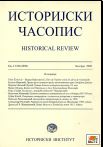Српска школа у Вишеграду (1865-1875)
Serb School in Višegrad (1865-1875)
Author(s): Nenad UrićSubject(s): History
Published by: Istorijski institut, Beograd
Keywords: Višegrad; elementary school; 19th century; Bosnia and Herzegovina; Serbia; textbooks; teachers
Summary/Abstract: The Serb elementary school was opened in Višegrad in mid-1860s, the first one in the city in Turkish times. The school was opened by the Višegrad people-church municipality, with the aid of Prince Mihailo and the Serbian government. The land for the school was provided by Nikola Hadži Selaković, retired judge from Belgrade, but whose family was from Višegrad. From the very opening, the school encountered difficulties from the local Turkish authorities, even though it had legal permit to work. Similar difficulties were encountered by other Serb municipalities in Bosnia and Herzegovina that wished to establish schools. The position of Serb schools was closely related to the position of the Serb Church in Turkey, which did not have its own church organization at the time, as did the Greek, and, a bit later, Bulgarian Churches (1870). From mid-1860s, the Turkish state tried to increase its control over Christians’ elementary schools, even though they were not financed by it, like the Muslim religious schools. The school worked until the start of the 1875 uprising in Bosnia and Herzegovina. The paper traces the influence of the priests and monasteries on the development of education in the Višegrad area, especially the aid given by Serbia. It lists teachers who worked there. It tries to establish which textbooks were used in teaching, and what was the general education level before the uprising. Almost all the textbooks were provided free of charge by the Ministry of Education of the Princedom of Serbia. Even though the school was intended to be secular, political circumstances towards the end of the Turkish rule influenced that the Višegrad, just like other schools in Bosnia and Herzegovina, remained very much influenced by the Church, making it in essence closer to church and monastery schools from the previous decades of the Turkish rule.
Journal: Историјски часопис
- Issue Year: 2008
- Issue No: 57
- Page Range: 253-282
- Page Count: 30
- Language: Serbian

